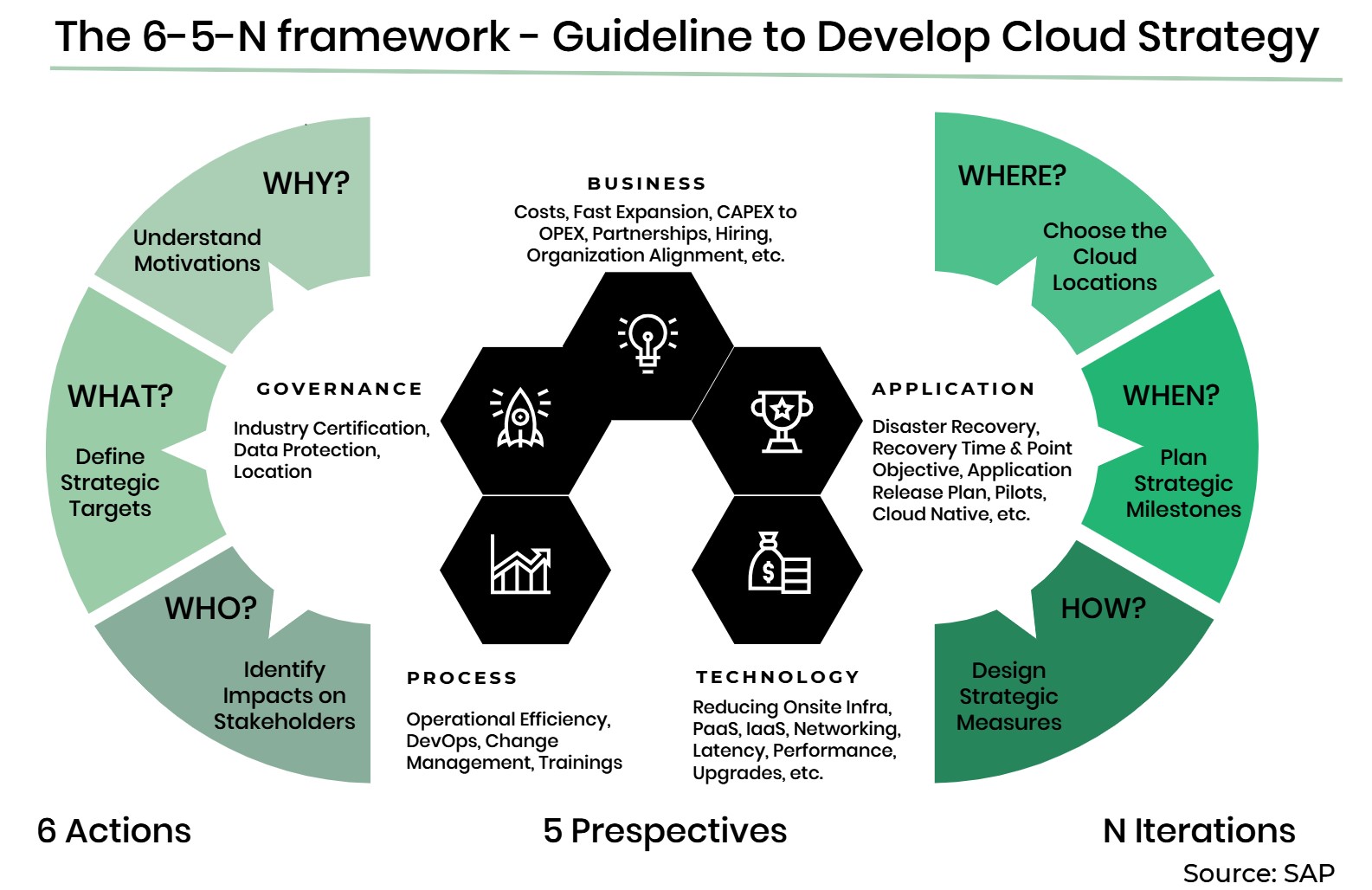
Is your business still playing catch-up while others sprint ahead? Say hello to enterprise cloud strategy – the not-so-secret weapon that's helping companies leapfrog their competition and reshape entire industries. But today’s enterprise cloud strategy is much more complex than just 10 years ago. Advancements in technology deployment, communication, and integration capability make for a substantial challenge in today’s enterprise environment. This article will outline the various aspects of enterprise cloud strategy considerations at a high level. In addition, we will propose an answer on how to best manage the massive amounts of programs and projects that today’s cloud environments present us with.
Amidst today's dynamic business landscape, not having an enterprise cloud strategy can put your organization's data security at risk. Crafting an effective enterprise cloud strategy has become a pivotal endeavor for organizations striving to stay ahead of the curve. Think of your enterprise cloud strategy as the blueprint for your business's digital journey—a meticulously thought-out plan that empowers you to harness the true potential of cloud computing to drive agility, cost savings, and collaboration. Just as an architect designs a structure that seamlessly blends form and function, your cloud strategy is the architectural masterpiece that shapes the future of your enterprise.
Cloud computing offers a range of benefits, including enhanced collaboration, easy access, and fast turnaround. However, to take full advantage of these benefits, it is essential to have a well-defined enterprise cloud strategy. Let's explore enterprise cloud strategy, elements to keep in mind when crafting a cloud strategy, and its benefits, as well as share the latest enterprise cloud strategy trends.
Defining the Enterprise Cloud and Its Strategy
Envision your organization as a dynamic metropolis, with each department akin to a distinct neighborhood, each with unique needs. The enterprise cloud functions as the digital infrastructure seamlessly weaving these neighborhoods together, facilitating fluid data storage, management, and processing—a citywide collaboration hub. Your enterprise cloud strategy serves as the master blueprint, detailing the migration, deployment, and growth of applications and data in the cloud. It encompasses benefits, risks, and technology integration. These initiatives greatly benefit from robust project management predictive intelligence solutions, which act as a guiding compass for precise enterprise cloud strategy execution, aligning each stride with your enterprise's aspirations.
Within the enterprise landscape, your enterprise cloud strategy harmonizes with the overarching business trajectory, considering objectives, goals, and financial contours. It seamlessly integrates existing IT assets, encompassing personnel, software, and hardware. With adept project management, this alignment persists throughout execution, seamlessly merging technology with strategic foresight. A well-forged enterprise cloud strategy unites your business aims with technological adeptness, fostering discerning choices that thrust your enterprise ahead.
"Without a strategy, execution is aimless. Without execution, strategy is useless."
-Morris Chang, CEO of TSMC
Why Your Business Needs an Enterprise Cloud Strategy
In the ever-evolving digital arena, a cloud strategy is your North Star, providing unwavering direction and purpose. Amid the landscape of cloud integration, a technology leader's discerning grasp of project management's strategic prominence is foundational to success. By leveraging modern tech solutions, you heighten decision-making, streamline resource allocation, and ensure each step advances success. Consider these compelling reasons:
- Agility Advantage - Cloud mastery empowers nimble adaptation amidst perpetual change, akin to a chameleon in its habitat. A well-honed cloud strategy flexes your business muscles, enhancing your competitiveness.
- Cost Precision - Cloud computing reshapes cost dynamics, shifting from fleet ownership to on-demand services. By leveraging your strategic plan for efficient resource allocation and curbing waste, you can optimize returns remarkably.
- Innovation Nexus - The cloud fuels innovation like a bustling market, where ideas flow unbounded. By utilizing advanced technology, teams can collaborate seamlessly, transcending borders and nurturing innovation.
- Scalability Spectrum - Cloud services, mirroring a retailer's shelf restocking, offer unmatched scalability. Your strategy enables seamless resource scaling in sync with dynamic business needs.
Navigating Enterprise Cloud Strategy Paths
Imagine embarking on your cloud journey as setting sail across a vast ocean, with numerous paths guiding you to your destination. Your enterprise cloud strategy serves as the compass steering you through these avenues:
- Public Cloud - Think of it as a bustling marketplace, offering agility and adaptability. Imagine choosing from an array of services, paying solely for what you use.
- Private Cloud - This is your own gated community, prioritizing privacy and control. Ideal for strict compliance and safeguarding sensitive data.
- Hybrid Cloud -Envision a car seamlessly shifting between fuels. The hybrid cloud merges private and public services, providing scalability and mastery.
- Multi-Cloud - Similar to a diverse investment portfolio, it prevents reliance on a single source. Just as you'd diversify investments, leverage multiple cloud providers for optimal services, avoiding entanglements.
Building an Effective Enterprise Cloud Strategy
As a technology leader, you wield the power to ensure each step is executed with precision. Your enterprise cloud strategy serves as the compass that steers your organization toward a brighter, more innovative tomorrow. While cloud transition is a complex initiative, it can be simplified to a remarkable extent by leveraging an advanced predictive intelligence solution. Technologies that capture and analyze every step you take towards progressing your initiatives, can ensure you are on track and on top of any issues in advance.
Building an effective enterprise cloud strategy involves several steps, including:
- Defining goals and objectives - Defining goals and objectives for cloud adoption, including cost savings, scalability, and flexibility.
- Assessing current IT infrastructure - Assessing your current IT infrastructure, including hardware, software, and personnel.
- Evaluating cloud providers - Evaluating different cloud providers and services to find the best fit for your organization.
- Developing a migration plan - Crafting a migration plan that outlines how you will move your data and applications to the cloud.
- Developing a risk mitigation plan - Developing a risk mitigation plan for cloud migration involves assessing risk appetite, evaluating cloud providers, and establishing a cyclical risk assessment process.
- Implementing cloud services - Implementing cloud services in a phased approach, starting with non-critical applications and gradually moving to more critical applications.
- Monitoring and optimizing - Monitoring your cloud services and optimizing them as needed to ensure you are meeting your goals and objectives.

Overcoming Challenges in Enterprise Cloud Strategy
An enterprise cloud strategy can present several challenges, including:
- Security risks - Cloud computing can present security risks, including data breaches and cyberattacks.
- Integration issues - Integrating cloud services with existing IT infrastructure can be challenging.
- Cost management - Cloud services can be expensive, and organizations must manage costs carefully.
- Vendor lock-in - Organizations must be careful to avoid vendor lock-in, where they become dependent on a single cloud provider.
Moreover, continuously monitoring a large-scale initiative that involves a series of projects presents major challenges for businesses. The lack of real-time insights leads to delays in decision-making and the loss of potential opportunities. The absence of effective and advanced solutions makes it challenging to establish accountability and transparency within the team. Nevertheless, utilizing analytical and collaborative project solutions can effectively address these issues and ensure transparency, accountability, and overall success.
The global cloud computing market was worth USD 445.3 billion in 2021 and is expected to grow to USD 947.3 billion by 2026. (Source: CIO&Leader)
Pivotal Elements for Creating an Enterprise Cloud Strategy
- Business and Technology Alignment - Ensure your enterprise cloud strategy aligns seamlessly with overarching business goals and technological capabilities.
- Risk Management and Mitigation - Identify potential pitfalls and challenges and craft proactive measures to mitigate risks.
- Operating Model Design - Devise an efficient operating model that optimizes processes and resource allocation in the cloud environment.
- Financial Management - Implement a comprehensive financial framework, adeptly managing costs and budget allocation.
- People and Culture - Foster a cloud-centric culture by empowering personnel to embrace and maximize cloud technologies.
- Sourcing and Vendor Management - Strategically select cloud providers and manage vendor relationships for optimal outcomes.
- Architecture and Technical Design - Design a robust cloud architecture, ensuring scalability, security, and seamless integration.
The top inhibitors to multi-cloud programs are cost concerns (51%), security concerns (47%), and lack of in-house skills (41%. (Source: CIO&Leader)
Eight Enterprise Cloud Strategy Trends
Cloud computing is evolving rapidly, and organizations must keep up with the latest trends to stay competitive. Here are eight enterprise cloud strategy trends to watch in 2023:
- Innovation Acceleration - Enterprise cloud strategy increasingly drives innovation, becoming a catalyst for business growth and transformation.
- AI Integration - Artificial Intelligence is woven into cloud strategies, enhancing decision-making and predictive capabilities.
- Serverless Computing Surge - Serverless architecture gains prominence, offering efficient resource management and scalability.
- Edge Computing Evolution - Edge computing is harnessed, empowering real-time data processing and reducing latency.
- Multi-Cloud Strategy - Organizations embrace multi-cloud setups, optimizing services from various providers to avoid vendor lock-in.
- Containerization Dominance - Container technologies like Kubernetes gain traction, simplifying application deployment and management.
- Sustainable Cloud Practices - Environmental consciousness drives the adoption of eco-friendly cloud practices.
- Quantum Computing Exploration - Enterprises explore quantum computing's potential within their cloud strategies.
The top cloud security concerns are data and privacy protection (40%), data theft (33%), and regulatory compliance (31%). (Source: CIO&Leader)
The Way Forward
As cloud computing continues its rapid evolution, organizations must stay attuned to the latest trends to remain competitive. However, implementing a cloud strategy is complex – without a doubt. While challenges exist—security risks, integration issues, cost management, and vendor lock-in—they can be overcome with a strategic approach.
Implementing an airtight enterprise cloud strategy involves different steps, stakeholders, and many integrated projects. Doing all of this together is challenging and you need every capability to ensure that you don't end up in a failure. Success should not be left to chance and dependent upon individual application deployments. Making sure that every individual project/initiative in your cloud implementation strategy is a success is critical. So, how can you ensure a seamless and successful process? The answer lies in leveraging a solution that can track and assess projects at all levels, providing a comprehensive picture of all of your projects’ health, and advanced warning of troubled or pending failure.
This is where TrueProject, a predictive intelligence solution for improving project health and performance, can play a critical role. It is a solution that combines predictive analytics, AI, and industry best practices that monitor your projects at multiple levels to provide you with real-time analysis of your projects’ health. Hosted on an enterprise cloud platform, it facilitates effortless collaboration and streamlines project execution. With advanced analytics, TrueProject empowers decision-makers with downstream views and real-time insights, thereby significantly contributing to a successful cloud strategy execution.
More information on TrueProject can be found at trueprojectinsight.com

About the Author:
Serving as the CEO at TrueProject, Tom Villani plays a major role in shaping the company's strategic direction, driving growth, and fostering a culture of innovation. Prior to his role at TrueProject, Tom worked as the Senior Vice President, Digital Innovation of CAI, Vice President of Global Alliances and Partners at Hitachi Vantara, and key senior executive roles with Information Builders, MicroStrategy, and AT&T. Tom also serves in advisory board capacities in the areas of Big Data and IoT.
Endnotes:
- John Edwards. “7 enterprise cloud strategy trends for 2023.” CIO: May 09, 2023. https://www.cio.com/article/236487/enterprise-cloud-computing-trends.html
- Geek Culture. “A Step-by-Step Guide to an Effective Cloud Strategy.” Medium: December 02, 2022. https://medium.com/geekculture/a-step-by-step-guide-to-an-effective-cloud-strategy-6e10f5251692
- NordLayer. “Building a winning enterprise cloud strategy: a comprehensive guide.” NordLayer: July 11, 2023. https://nordlayer.com/blog/enterprise-cloud-strategy-guide/
- Laurence Goasduff. “Gartner Highlights Seven Elements for Creating an Enterprise Cloud Strategy.” December 08, 2020. https://www.gartner.com/en/newsroom/2020-12-08-gartner-highlights-7-elements-for-creating-an-enterprise-cloud-strategy
- Christy Pettey. “6 Steps for Planning a Cloud Strategy.” Gartner: March 21, 2022 https://www.gartner.com/smarterwithgartner/6-steps-for-planning-a-cloud-strategy#:~:text=Design%20a%20cloud%20strategy%20that%20optimizes%20for%20business,creative%20recruiting%20strategies%20to%20bridge%20the%20talent%20gap
- CIO&Leader. “76% Of Enterprises Have Already Adopted A Multi-Cloud Strategy: Survey.” CIO&Leader: August 16, 2021. https://www.cioandleader.com/article/2021/08/16/76-enterprises-have-already-adopted-multi-cloud-strategy-survey
- Ravi Sharma. “How to derive your viable cloud strategy? A case for SAP Hana Enterprise Cloud – a Multi-cloud offering. – Part 1.” SAP: December 11, 2018. https://blogs.sap.com/2018/12/11/how-to-derive-your-viable-cloud-strategy-a-case-for-sap-hana-enterprise-a-multi-cloud-offering.-part-1/





